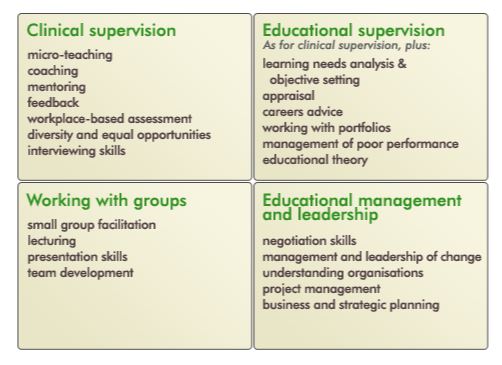Teaching in the clinical setting, whether in secondary or primary care, will involve certain types of educational activity. We have identified four such areas. Areas which inevitably overlap, and are by no means exhaustive, but that describe those educational activities in which healthcare educators tend to be commonly engaged. They are:
Clinical/placement supervision and mentorship
Day-to-day supervision in the clinical setting. Clinical supervision involves being available, looking over the shoulder of the learner, teaching on-the-job with developmental conversations, regular feedback and the provision of a rapid response to issues as they arise. All learners should have a named educator for each post/placement, who must be able to tailor the level of supervision to the competence, confidence and experience of their learner and undertake workplace-based assessment(s).
Educational supervision/mentorship
The supervision of a learner’s progress over time. Educational supervisors and mentors are responsible for ensuring that learners are making the necessary clinical and educational progress. Educational supervisors and mentors will need all the skills of clinical supervision, plus an appreciation of supporting educational theory, the ability to undertake appraisal, work with portfolios and provide careers advice. Managing the learner in difficulty will also, inevitably involve the educational supervisor / mentor.
Working with groups
From the facilitation of an action learning set to the delivery of a lecture, working with groups, both small and large, involves a set of skills that will be required by most educators in the clinical setting at one time or another during their career.
Educational management and leadership
Clinical education is a complex area, subject to rapid and often turbulent change, with those in management positions faced with the double burden of maintaining a service whilst providing meaningful learning for the next generation of clinicians. The system requires effective management and leadership, and all those involved in its organisation - from training programme director to practice placement educator, from clinical tutor to mentor - will need the management and leadership competences to keep patients safe whilst ensuring excellence in education.

